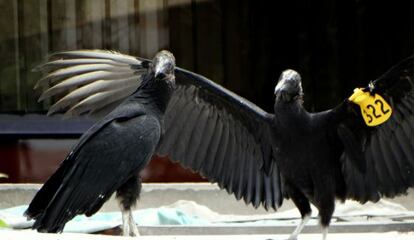Vultures help track garbage in Lima
Scientists equip black vultures with GPS and cameras to warn about trash problem

Scientists in Peru are using vultures to study the build-up of garbage in Lima, and help the government promote a public-awareness campaign about the importance of recycling.
Around 10 black vultures – a species common in Lima – have been equipped with GPS and GoPro video cameras to monitor the areas where the city’s trash accumulates. This information is then used in an advertising campaign, which encourages citizens to report the focal points of contamination in their neighborhoods.
With a population of 8.4 million people, Lima suffers from its residents piling their garbage up on the streets
“It’s not uncommon for things that are so close to us to go completely unseen,” says César Arana, a biologist who is in charge of the program.
Arana is the coordinator of the ecological division at the Natural History Museum at Lima’s San Marcos University. He has helped develop the program, which began on December 7, and allows scientists to track the large birds from the moment they sleep to feeding time in trash piles.
With a population of 8.4 million people, Lima suffers from its residents piling their garbage up on the streets. According to Peru’s Environment Ministry, just 41.9% of the garbage collected by municipal workers in 2013 was taken to official dump sites, only 10 of which exist in the entire country.
Letty Salinas, director of ornithology at the museum, explains that the experiment began in August when they captured the first black vultures. Special nets were used to prevent injuring the birds, with the help of a wildlife veterinarian. Biology students examined the vultures to see if they were healthy enough to take part in the project.
Tons of electronic waste
According to the Peruvian Environment Ministry (Minam), 250 urban and rural municipalities in the country are separating waste for recycling, and about 25% of the households in these municipalities are adopting the habit.
But for the environmental authority, the increasing use of electrical devices and electronics has become a problem because municipal collection services do not accept such waste and informal recyclers do not know how to handle these elements and hazardous substances.
Minam said that computer and electrical equipment will generate this year some 155,200 tons of waste in Peru.
“In the city, they are not just found where there is trash they can feed on; they also sleep and rest in very clean areas,” says Salinas.
The Environment Ministry and USAID-Peru (a US international development program run by the State Department) hired the publicity firm FCB Mayo Peru to come up with a publicity campaign to make people aware about the need to properly get rid of their trash and encourage them to recycle.
Garbage buildup in the Peruvian capital has been a problem for years.
“We had to do something innovative since publicity campaigns compete with one another with too many messages. We drew the conclusion that the answer was in the sky,” says Flavio Pantigoso, creative director at Mayo, in reference to the hundreds of circling vultures seen throughout Lima.
The publicists got in contact with the biologists, who were still not convinced that the project would work but decided to collaborate with them anyway.
“It is an important bird for maintaining the ecosystem, for converting decomposing organic waste into living matter, but taxonomically speaking, it is one of the most threatened. However, we do not know how long they live or if they change their habits or resting places when they get older,” says Arana.
The biologists get all their information from the GPS and GoPro cameras attached to the birds. Although the publicity campaign will last a month, the investigation and research will continue for at least two years.
“We want to demonstrate how these birds have adapted to city conditions. We live with them without thinking about their habits, their will to survive, and how they comply with their role in the ecosystem,” he says.
All the information gathered by the black vultures from the air is shared with the public through an internet platform. People can see the birds’ changing locations through Google Maps and track their routes thanks to messages posted by citizens on social media.
Other cities such as Arequípa and Huaral have expressed interest in joining the project, but Alejandro Rivas, who coordinates the internet platform, says expansion would have to be decided by USAID.
English version by Martin Delfín.
Tu suscripción se está usando en otro dispositivo
¿Quieres añadir otro usuario a tu suscripción?
Si continúas leyendo en este dispositivo, no se podrá leer en el otro.
FlechaTu suscripción se está usando en otro dispositivo y solo puedes acceder a EL PAÍS desde un dispositivo a la vez.
Si quieres compartir tu cuenta, cambia tu suscripción a la modalidad Premium, así podrás añadir otro usuario. Cada uno accederá con su propia cuenta de email, lo que os permitirá personalizar vuestra experiencia en EL PAÍS.
¿Tienes una suscripción de empresa? Accede aquí para contratar más cuentas.
En el caso de no saber quién está usando tu cuenta, te recomendamos cambiar tu contraseña aquí.
Si decides continuar compartiendo tu cuenta, este mensaje se mostrará en tu dispositivo y en el de la otra persona que está usando tu cuenta de forma indefinida, afectando a tu experiencia de lectura. Puedes consultar aquí los términos y condiciones de la suscripción digital.
Últimas noticias
Most viewed
- Pablo Escobar’s hippos: A serious environmental problem, 40 years on
- Why we lost the habit of sleeping in two segments and how that changed our sense of time
- Charles Dubouloz, mountaineering star, retires at 36 with a farewell tour inspired by Walter Bonatti
- Reinhard Genzel, Nobel laureate in physics: ‘One-minute videos will never give you the truth’
- The Florida Keys tourist paradise is besieged by immigration agents: ‘We’ve never seen anything like this’








































